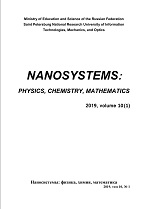|
This article is cited in 2 scientific papers (total in 2 papers)
CHEMISTRY AND MATERIAL SCIENCE
Optimizing the carbonization temperature in the fabrication of waste cotton based activated carbon used as electrode material for supercapacitor
Nguyen K. Thachab, Ilya S. Krechetova, Valentin V. Berestova, Tatyana L. Lepkovaa, Svetlana V. Stakhanovaac
a National University of Science and Technology "MISIS", Moscow, Russia
b Vietnam National University of Forestry, Hanoi, Vietnam
c Mendeleev University of Chemical Technology of Russia, Moscow, Russia
Abstract:
H$_3$PO$_4$-impregnated waste cotton was used as precursor to fabricate high porous activated carbon (AC) by the carbonization and activation processes with ultrahigh heating rate. The obtained activated carbon has unique physicochemical properties such as the structure mainly amorphous and ultrahigh specific surface area of 2769.7 m$^2$/g for samples fabricated at carbonization temperature of 600$^\circ$C. The double-layer supercapacitors with activated carbon electrodes and electrolyte based on 1,1-dimethylpyrrolidinium tetraflu-oroborate solution in acetonitrile of 1 M concentration were fabricated. The specific capacitance of electrode material fabricated from AC obtained at carbonization temperature of 600$^\circ$C reached 110.8 F/g at the current density of 50 mA/g and 85.1 F/g at 1000 mA/g. At 1000 mA/g, the degradation was less than 25% after 5000 charge/discharge cycles. The carbonization temperature of 600$^\circ$C is considered as optimum for fabricating activated carbon and the obtained activated carbon can be used for supercapacitor electrode materials.
Keywords:
cotton, waste cotton, activated carbon, porous carbon, electrode material, supercapacitor, cellulose.
Received: 13.07.2022
Revised: 21.09.2022
Accepted: 02.10.2022
Citation:
Nguyen K. Thach, Ilya S. Krechetov, Valentin V. Berestov, Tatyana L. Lepkova, Svetlana V. Stakhanova, “Optimizing the carbonization temperature in the fabrication of waste cotton based activated carbon used as electrode material for supercapacitor”, Nanosystems: Physics, Chemistry, Mathematics, 13:5 (2022), 565–573
Linking options:
https://www.mathnet.ru/eng/nano1139 https://www.mathnet.ru/eng/nano/v13/i5/p565
|

| Statistics & downloads: |
| Abstract page: | 71 | | Full-text PDF : | 29 |
|




 Contact us:
Contact us: Terms of Use
Terms of Use
 Registration to the website
Registration to the website Logotypes
Logotypes








 Citation in format
Citation in format 
